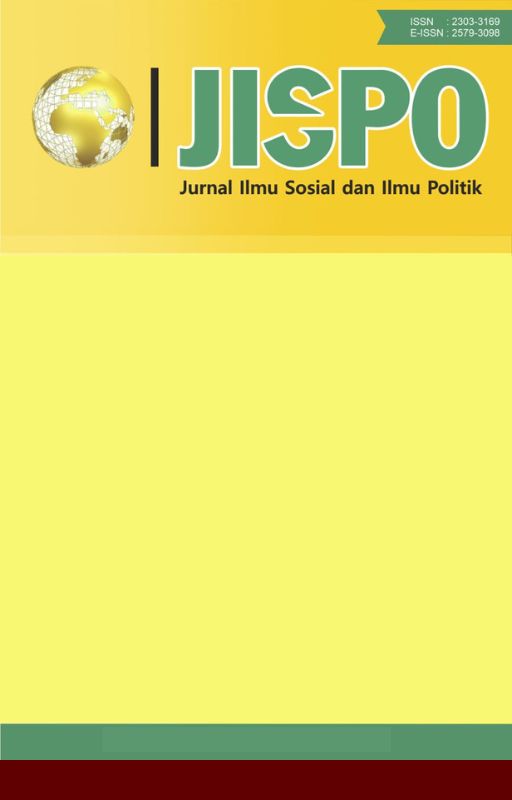ANALISIS SKENARIO KEMITRAAN KEHUTANAN ANTARA GAPOKTAN RIDING BERSATU DAN PT. BUMI MEKAR HIJAU (Suatu Kasus di Desa Riding Kecamatan Lampam Kabupaten Ogan Komiring Ilir, Provinsi Sumatera Selatan)
DOI:
https://doi.org/10.15575/jispo.v9i1.4150Keywords:
Farming Culture, Forestry Partnership, Policy, Scenario.Abstract
References
Agus, F., Wahyunto, H. S., Subiksa, I. G. M., Prihasto, S., Ai Dariah, M., Neneng, I., & Nurida, M. H. (2014). Pengelolaan Berkelanjutan Lahan Gambut Tergredasi: Trade-off Keuntungan Ekonomi dan Aspek Lingkungan. Prosiding Seminar Nasional. Pengelolaan Berkelanjutan Lahan Gambut Terdegradasi Untuk Mitigasi Emisi GRK dan Peningkatan Nilai Ekonomi. Badan Penelitian dan Pengembangan Pertanian. Kementrian Pertanian, Jakarta.
Borjeson, L., Hojer, M., Dreborg, K.H., Ekvall, T. Finnveden, G. (2006). Scenario types and techniques: Towards a user’s guide. Jurnal Elsevier, Futures, 38, 723–739
Nicholls, C. I., Altieri, M. A., & Vazquez, L. (2016). Agroecology: principles for the conversion and redesign of farming systems. Journal of Ecosystem and Ecography S, 5.
Nilsen, H. R. (2010). "From weak to strong sustainable development: An analysis of Norwegian economic policy tools in mitigating climate change."
Socla. (2015). Agroecology: Key Concepts, Principles and Practices. Socla.
Sodikin, M. (2018). Kajian Teknis Perencanaan Penataan Lahan dan Sistem Tata Air Untuk Budidaya Tanaman di Lahan Kehidupan Konsesi PT. BMH. Universitas Sriwijaya.
Soeprihanto, P. Y. I. (2014). Dunia Usaha Kehutanan: Besar Tapi Tak Berdaya Lestari Tanpa Saing. APHI. Jakarta.
Srihandono, I. (2005). Hutan Tanaman Industri: Skenario Masa Depan Indonesia. PT. Musi Hutan Persada. Palembang. Indonesia.
Suharjito, D., Sundawati, L., Suyanto, S. R. U., & Utami, A. R. (2003). Aspek Sosial Ekonomi dan Budaya Agroforestry. Bahan Ajar, 5.
Tata, H. L., & Susmianto, A. (2016). Prospek Paludikultur Ekosistem Gambut Indonesia. Pusat Penelitian dan Pengembangan Hutan (FORDA, MoEF) and Wetlands International Indonesia.
Tata, H. L. (2018). Teknik Paludikultur Untuk Adaptasi dan Mitigasi perubahan Iklim di Ekosistem Gambut. Seminar Hasil Penelitian Penguatan Aksi Mitigasi dan Adaptasi perubahan Iklim. Jakarta, 17 Januari 2018.
Undang-Undang Tentang Kehutanan No 41 Tahun 1999.
Peraturan Menteri Lingkungan Hidup dan Kehutanan No 12 Tahun 2015).
Ringland, G. (1998) Scénario Planning : Managing for the Future. England. John Wiley & Sons Ltd.
Rogers, P. P., Jalal, K. F., & Boyd, J. A. (2012). An introduction to sustainable development. Routledge.
Vallance, S., Perkins, H. C., & Dixon, J. E. (2011). What is social sustainability? A clarification of concepts. Geoforum, 42(3), 342-348.
Vayda, P. A., Walte rs, B.B., (1999). Against Political Ecology. Human Eco logy, Vol. 27, No. 1,167–178.
Widyantoro, B. & Maksum, J. (2016). Resolusi Konflik Lahan: Pembelajaran dari Hutan Tanaman Industri. Jakarta: APHI.
Downloads
Published
How to Cite
Issue
Section
Citation Check
License
Authors who publish their manuscripts in JISPO agree to the following terms:
- Authors retain copyright and grant the journal right of first publication with the work simultaneously licensed under a Creative Commons Attribution-ShareAlike 4.0 International License that allows others to share the work with an acknowledgment of the work's authorship and initial publication in this journal;
- Authors are able to enter into separate, additional contractual arrangements for the non-exclusive distribution of the journal's published version of the work (e.g., post it to an institutional repository or publish it in a book), with an acknowledgment of its initial publication in this journal; and
- Authors are permitted and encouraged to post their work online (e.g., in institutional repositories or on their websites) after publication process, or prior to and during the submission process, as it can lead to productive exchanges, as well as earlier and greater citation of published work (See The Effect of Open Access).




.jpg)



